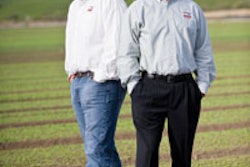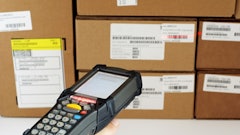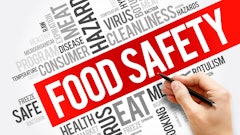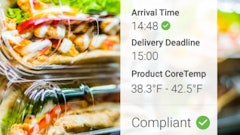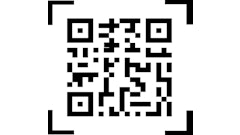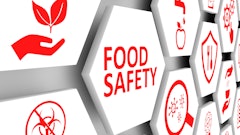
The food industry is still reeling from the knockout punch it suffered at the hands of the recent Peanut Corp. of America debacle, responsible for numerous deaths and sicknesses. Consequently, track-and-trace initiatives are being examined a lot more closely as the industry grapples with how to enhance the granularity of visibility into the supply chain. The goal is to pinpoint developing problems immediately to ensure safe food to consumers, eliminate the possibility of a calamitous recall and being prepared to react to a bioterrorism attack on the food supply.
A federal report released March 26, 2009 found the government’s system for tracing foods is “riddled with holes.” Investigators for Health and Human Services found they were able to follow only five of 40 foods throughout the supply chain. Although federal law mandates record-keeping procedures enabling the tracking of suspect foods one step back and one step forward, an astonishing 25 percent of company managers were unaware of these requirements.
These shortcomings at the federal level underscore the crucial responsibility the food industry faces first, to self-monitor and second, to work with government to develop fail-safe and comprehensive food safety standards and systems.
An AMR Research study last year found that, on average, it takes the industry about 34 days to enact a recall. Consequently, only about 40 percent of the affected product can be retrieved because it has either been consumed or thrown out.
As Rodney Bias cautions, “Preparation is the biggest part of a recall and it helps it go much more smoothly without any preparation.” Bias is vice president, regulatory compliance for Inmar CLS Reverse Logistics in Winston-Salem, NC.
To prepare for a potential recall, Inmar CLS recommends that companies ask themselves where they are at risk in their supply chains. “We help manufacturers and retailers develop protocols and organizational teams that would be involved in a recall,” says Ashley Kerman, director of recall client services. “We always tell our clients that the event of a recall is low probability, but the event itself carries a very high consequence.”
Technology is paving the way for standardization within the food industry, with an eye toward delivering safe food and quickly reacting to a recall. Congress is currently reviewing H.R. 875 Food Safety Modernization Act of 2009. “This is the first time I have ever seen a major piece of legislation of this kind,” says John Ryan, PhD, project administrator and administrator for the Sate of Hawaii Department of Agriculture in Honolulu. The bill’s goal is to consolidate the piece-meal standards that currently exist, creating a centralized food safety group.
Global standards are also evolving in the industry, notes Jeff Tazelaar, RFID product manager for Lowry Computer Products in Brighton, MI. “We are seeing, through the initiatives of EPC Global and GS1, the development of standards for identifying products and sharing the associated data across the enterprise, which weren’t there several years ago.”
TRACK-AND-TRACE EVOLUTION
Other food segments are watching closely the effects of the Produce Traceability Initiative (PTI), with an eye to possibly mimic the initiative’s capabilities with its focus on identifying specific lot numbers. The produce industry’s move to more specific product identification through the PTI is a major step forward for the food industry, says Steve Arens, director of industry development for GS1 US in Lawrenceville, NJ. GS1 is a not-for-profit organization—with over 100 country-specific entities globally—dedicated to the adoption and implementation of standards-based, global supply chain solutions.
Over 200,000 companies use GS1-US for trading-partner collaboration and for maximizing the speed, efficiency, visibility and traceability of their goods moving around the world, says Arens.
Of course, the primary goal for the food industry is contamination prevention and delivering safe food to consumers. This means utilizing HACCP (Hazard Analysis and Critical Control Points) and Good Manufacturing Practices (GMP), as well as FDA and USDA inspections, says Jeanne Iglesias, senior director of supply chain and technology for Washington-based Grocery Manufacturers Association (GMA). In the rare instances where prevention fails, recall will involve notification, product removal and product destruction. Track and trace is the ability to locate goods either upstream or downstream in the food supply chain.
Iglesias adds that track-and-trace technology is still evolving, but that the barcode infrastructure is still prevalent within the CPG industry, whether that means using UPC or GTIN identification. “The barcode infrastructure is a tried-and-true mechanism to capture data from your suppliers at the batch-lot level, enabling traceability throughout the supply chain because it is interoperable and everyone along the chain can read and scan barcode,” she says.
Although RFID is not yet prevalent, its enhanced data-capture capabilities are without doubt. Implementation hurdles in the industry involve cost and data quality challenges in certain environments. “We are challenging RFID providers to get us over those hurdles and make RFID applicable across the board,” Iglesias says, adding that some GMA members are involved in pilot testing with retailer partners.
On the other hand, European and other countries overseas use RFID aggressively in the food industry. So why isn’t it used as much here in the United States? Arens of GS1 says the aggressive use overseas could be driven by government activity or funding. He adds that there is a fair amount of RFID use in the U.S. produce industry.
Barcode and RFID are the primary technologies used in the food industry, say some experts. Lora Cecere, vice president for consumer products at AMR Research in Boston, offers a broader perspective. She explains the technologies include warehouse management systems that track units in a warehouse; multi-tier quality systems that track product lot codes; and manufacturing master data systems tracking items through manufacturing and transformation processes by tracking lot codes through manufacturing execution systems (MES).
Currently, beef, pork and poultry industries are examining PTI activity in the produce industry. “We expect those industries to be on a similar path soon,” says Arens. He adds that once the spinach, cantaloupe and tomato recall hit, the produce industry wanted to control its own destiny and took the lead in designing and planning this traceability initiative, rather than waiting for the government to tell it what to do.
The PTI will allow the industry to narrow down suspected products within the supply chain. “Our GS1 standards are helping companies move toward supplier identification at the case level,” explains Arens. “With product and brand identification, a recall situation can be limited to the affected brand only so the whole category doesn’t have to be destroyed, as in the tomato and pepper incident last year where the industry destroyed between $250 million to $300 million worth of products.”
GS1-128 can identify the product, its lot number, the location from which it was shipped, the use-by date, sell-by date and other data. “This symbology is more flexible and can hold more data than the UPC, which is a fixed format that only identifies the product,” explains Arens. “So the trend here is to move from the theme of commodity identification to specific identification of the grower, packer and brand owner.”
ILLUMINATING THE FOOD CHAIN
What exactly is the architecture of the data environment in which track-and-trace technologies perform? Generally, data is collected through supply chain execution systems and manufacturing execution systems. Some technology providers also use Web-based applications.
As Matthew Littlefield says, “It is very difficult to cast out nets properly to capture contaminated food once a non-conformance event is initiated.” Littlefield is senior research analyst at Boston-based Aberdeen Group. One metric of interest to Aberdeen, monitored in several studies, was track-and-trace response time. “From our perspective, the top performers improving overall food safety are the companies who integrate the various data sources coming from food processing, warehouse management and distribution to the customer.”
This means eliminating silos, continues Littlefield. “Very often each food processing facility is siloed so a large food manufacturer wouldn’t understand how to track and trace non-conforming or adverse events across different manufacturing facilities. Furthermore, they don’t have the ability to track and understand how lots from one facility move through the distribution system.”
Track-and-trace capabilities can also include the consumer, explains Littlefield. Consumer complaints can connect back to operations or distribution through a CRM system, which can enrich tracking data.
Littlefield offers a conceptualization of the technology architecture. ERP—the backbone of the enterprise orchestrating the various technologies involved within the enterprise—manages orders, inventory and financials. Operating as an extension of ERP is the MES that manages food processing. “Many food-safety issues happen on the shop floor and how and when they occur needs to be understood in order to do forward and backward traceability throughout the supply chain,” he says.
On the supply chain side are WMS solutions like Red Prairie that manage pallets through the warehouse. Another source of traceability is RFID, tracking pallets through the warehouse to the retailer. Here is a look at some of the prevalent technologies in food logistics today.
Barcode Technology: RedPrairie Corp. offers the food industry a strong inventory database model that collects a comprehensive list of inventory attributes for raw materials and finished goods, notes Tom Kozenski, vice president, product strategy for the Milwaukee-based company. “We track the necessary attributes like lot numbers, manufacturing codes, supplier code dates and inventory statuses.”
RedPrairie’s Warehouse Management Solutions can accommodate a variety of technology options, including RFID and barcode (see sidebar “Cabot Creamery Prevents Recall With WMS,” page 20).
There is no chance to overlook or omit necessary data, as the system’s discipline forces users to capture data through prompts. Managing quality control in the inspection processes ensures food safety, Kozenski says. “For instance, with a trusted supplier, we might test 10 percent of their products to make sure it passes quality control testing. But for an unknown supplier, we might test 100 percent of their products for quality. This is done in the plant, in the warehouse, and at the processing stations. We can even check quality at suppliers’ facilities because we have Web-based applications we can share with suppliers that allow them to create an inventory and identify the quality status before the products are even picked up.”
Through its transportation application, RedPrairie tracks “inventory in motion,” which can alert a driver not to deliver bad inventory he is carrying on his truck. “From an accountability perspective, the Bioterrorism Act of 2002 requires us to track the carrier, the driver, and even the driver’s license number so we have data pertinent to everyone who touched the inventory,” Kozenski says.
RFID Technology: While some obstacles—primarily cost—still inhibit RFID growth throughout the industry, major pilots and even actual implementations are demonstrating exceptional success. (See sidebar “Hawaii Piloting RFID For Produce Tracking,” page 21).
Ryan at the State of Hawaii believes it is just a matter of time until the price is right for RFID, likening trending technology development to that of computers or cell phones: big, bulky and expensive at first, then smaller and cheaper. “This trend is well established in technology, where you have a few players initially and with more players and technology advances, prices erode; I am seeing that already,” he says.
Beyond just tracking, the industry standard will embrace an enhanced preventive safety approach, Ryan predicts. He says the track-and-trace abilities of barcode offer limited applications for comprehensive food safety. “Traceability is a critical part of food safety and you should be able to monitor temperatures on shipments.”
Lowry’s Tazelaar adds that RFID visibility goes beyond barcode data that typically provides company information and product type. “RFID tags, encoded with EPCs, are capable of identifying exact items of products and certain tags have the ability to monitor temperatures of those products. The real value is the ability to access this data, through stand communication methods across trading partners, to make real-time business decisions. For instance, the system can send alerts if produce, for example, is left sitting in 90-degree weather for too long. The alert will initiate either expediting the product or inspecting it to assure shelf life has not been impacted because of the exposure.”
In the event of a recall, RFID enables the ability to trace exact products through the supply chain as they are shipped on full pallets and broken down during the distribution process into multiple-store deliveries.
“The grower can quickly find all the products that were picked in the same hour and do a lookup for the exact EPCs across all of their trading partners,” Talezaar says. “The standards to do this type of lookup for traceability are developed within GS1 and EPC Global, adding value. These standards also improve visibility across operations, which lie in the hands of the application development community.”
Furthermore, RFID could enhance the inspection process if the FDA would invest not only in its visual inspections, but in technology to detect microbial and chemical contaminants inspectors cannot see, advises Ryan. “RFID sensors could potentially talk to an RFID backbone and issue real-time alerts if they detect any contaminants so those contaminants can be captured and destroyed.”
Web-Delivered Barcode: YottaMark in Redwood City, CA, offers its HarvestMark traceability solution, compatible with PTI and with GS1 standards. The Web-delivered service uses barcode format and collects supply-chain data in its server. The solution can also integrate into an ERP system, as it does with its Mexican grower/packer/shipper/re-packer, Del Campo (see sidebar titled "Del Campo Supreme Tracks From Field To Fork" at the end of this article.
“It provides one-up and one-back traceability,” explains Elliott Grant, chief marketing officer and founder. This is accomplished with the database information containing GTINs, lot numbers and the shipper’s name.
In the event of bad products, the first thing the CDC wants is good data, says Grant. “They can look for commonalities such as discovering all the sickened people ate cantaloupes from a particular GTIN and lot number. It quickly narrows down the problem to a particular lot number or farm. The key is all the other cantaloupes on the market can continue to be sold. “
TRACEABILITY: A HOLISTIC ENDEAVOR
In the final analysis, brand owners need to take more responsibility for monitoring product quality of their suppliers, advises AMR’s Cecere. “Brand owners should require their suppliers to be sharing quality data with them on a near real-time basis so they can track more effectively. “
Yet another factor plays into this discussion. The No. 1 pressure in the market about two years ago related to how pain-focused companies are as they aimed to reduce the cost of adverse events and recalls, notes Littlefield at Aberdeen. “Our customers told us this can really hurt their business. But today, there is a transition to be more customer- and quality-focused. For some leading companies, traceability is now more than just focused on eliminating the pain of a recall event; these companies also want to be more holistic and to improve the quality of the customer experience and customer loyalty.”
Cabot Creamery Prevents Recalls With WMS
Cabot Creamery in Montpelier, VT, always had good control over traceability of its bulk-state cheese. But once the large blocks of cheese were cut into eight-ounce bars and should a recall be necessary, Cabot anticipated it would need to recall at lease two or three days’ worth of product because it would not be able to know exactly where every case wound up, says Ralph Viscomi, senior vice president of information services.
“A recall is something we have always dreaded and fortunately never had to do. Although we had a good idea of where every case was, we couldn’t say definitely,” says Viscomi.
Cabot found the solution it was looking for in RedPrairie’s Warehouse Management Solutions product. Viscomi wanted firstly to have the DC operate more efficiently, then to be able to identify exactly where product was shipped and when it was shipped there.
“Since our warehouse didn’t have an automated system, we were running into code date issues frequently, with pallets sitting in the warehouse until they were discovered a week before the expiration date on the pallet,” Viscomi explains.
This meant selling products as animal food for pennies on the dollar. This was another cost factor motivating Cabot to automate its DC.
The RedPrairie system went live November 2008. “Now we know exactly where every case of product goes,” Viscomi says.
He adds that two months into using the system, Cabot got a real-world chance to see just how responsive the system is. The company received from its suppliers inaccurate UPC labels. “We were able to track exactly where those cases were and we halted them from being delivered to the customer before the truck arrived. My supply chain group was ecstatic about this capability.”
The system interfaces with five other Cabot systems. Of particular importance was the ability for RedPrairie to integrate the company’s internal inventory control system with its cost accounting system. “Since we age our cheese so long, we wanted to be able to account for that cheese accurately as its value changed over time,” explains Viscomi.
Products are tracked at the case and pallet level. RF scanners collect case barcode data that contains the item code, lot code, expiration date, case weight and case serial number. RF scanners also collect pallet barcode data that contains pallet ID, item code, lot code, expiration date, number of cases and total weight.
Viscomi notes a concern in the industry to maintain consistent item information throughout the supply chain. “A company might have anywhere from a few to eight different systems, each system using its own item master. Keeping those item masters in sync is a monumental job because often when someone makes a change to one item code in one system, they forget to change that item code in another system. This creates a lot of inconsistencies.”
Cabot now uses a global item master that automatically populates all relevant systems housing item masters.
The goal, of course, is speed to react. “If you have to do a recall, it is way too late,” says Viscomi. “The key is to be able to stop anything bad from going out the door and that is what this system allows us to do. If we find a problem, we can react and identify the problem vats or cases and stop them before they get to the customer.” —A.T.
Hawaii Piloting RFID Program For Produce Tracking
The Hawaii Produce Traceability Initiative, administered by the Hawaii Farm Bureau and the State of Hawaii Department of Agriculture, began in 2007 as a three-year RFID pilot designed to promote food safety by enabling product visibility from the field to farm, distributors and to supermarkets using Lowry Computer’s Fresh Harvest track-and-trace solution.
The pilot includes six farms producing tomatoes, mushrooms, pineapples, papayas and asparagus. The pilot will also track produce from California using RFID temperature sensor tags from Infratab to monitor temperature along the supply chain into Hawaii.
“This project provides the backbone for more preventive closed-loop sensor technologies capable of measuring and reporting bio-contaminants and temperature variations via RFID as produce moves through the supply chain,” Ryan explains.
Tazelaar notes he sees companies using barcode on item levels and RFID on cases and pallets because RFID technology is still too expensive to use at the item level. The six farms ship into a DC. Produce is then shipped to supermarkets.
“We tag cases at the farms and they are read when they leave the farms,” explains Ryan. “They are read when they enter the DC and when they leave. Upon arrival to the supermarkets, cases are read again and the final read is done at the floor level. “If any problems are detected, we would know exactly which case was involved. I want to see where everything is at any time and if something went wrong, I want to know where it happened so I can alert my people to get that product out of the system. This is what promotes an overall food safety system,” says Ryan.
As RFID tags are read, a wireless system Lowry helped to develop collects data and sends it to Ryan’s computer via the Internet.
“This is revolutionary-—I don’t think anyone has done this before,” Ryan says. “This project demonstrates how effective this model is. Our goal is to make it low-cost and accessible to more users.” —A.T.
GMA, FMI Outline Food Safety Initiatives, Recall Procedures
The Grocery Manufacturers of America (GMA) and the Food Marketing Institute (FMI) are making food safety a priority as they step up their efforts to improve food safety throughout the supply chain.
GMA has developed a food safety reform proposal that places new regulatory mandates on food companies and that provides the FDA with the resources it needs to protect consumers, including:
- A requirement that all food manufacturers have a food safety plan in place;
- A requirement that all food manufacturers have a foreign supplier safety plan;
- Increase in FDA food-related spending;
•Establishment of federal agricultural standards for fresh fruits and vegetables; - The adoption of a risk-based approach for FDA inspections;
- The establishment of mandatory recall authority for FDA in certain circumstances.
Food retailers have extensive systems to safeguard food and, when a recall occurs, to quickly remove products and alert consumers, said Mike Ambrosio, vice president, quality assurance, at the Wakefern Food Corp., when he testified before the House Small Business Subcommittee on Regulations and Healthcare in March.
Ambrosio walked members of Congress through Wakeferns’s recall procedures:
- Identified products are embargoed and segregated to a designated holding area;
- U.P.C. codes are locked out of point-of-sale (POS) systems so products cannot be scanned at checkouts or sold on the company website;
- A bulletin is sent to all store owners and applicable in-store divisions and management staff, and the information is posted on the company website;
- Class I recalls trigger automated phone calls that notify store owners and managers directly to reinforce the bulletin;
- Private third-party auditors visit company stores to ensure Class I recalled product has been removed from the shelves within a 24-hour period.
Del Campo Supreme Tracks From Field To Fork
Del Campo Supreme is the first Mexican shipper to use HarvestMark’s traceability solution, says Jim Cathey, general manager of the company’s Nogales, AZ, distribution center. The installation was completed recently and Cathey anticipates the solution’s instantaneous and granular traceability back to which farm grew the produce in which field.
The company produces about 10 million cases annually of greenhouse and field-grown Roman, grape, cluster and beefsteak tomatoes, and red, yellow and orange peppers.
Before implementing the system, Del Campo had an in-house system that traced at the case and pallet levels. “But we wanted to get to the next level in traceability,” Cathey says. He notes the salmonella problems last year when produce moved on to re-packers. “Once they start changing the pack styles and make consumer packs, they can hit a wall in traceability and the trail goes cold very quickly.”
At the field level, the HarvestMark code is scanned on boxes of clamshell grape tomatoes; then 12 clamshells are packed to a case, which is scanned again.
The data is collected in the company’s ERP system and shows which field the tomatoes were harvested from and who packed them. Cases are put on pallets and pallet tags are scanned.
“When the truckload of produce arrives here in our distribution facility, we scan the pallet tag again with handhelds and we have all the data collected while the produce was in transit to our facility,” explains Cathey. “Then when the produce leaves here, we scan it again.”
Through these processes at the ranch and at the DC, the collected data can tie products from individual clamshells to the case and the pallet it was shipped on enroute to the DC. “We have the time and date products were unloaded here, and the time and date it was unloaded onto a truck to be delivered and who it was shipped to so we can walk it all the way back through where it was packed in the field,” explains Cathey.
“All of these efforts mean true commitment to consumers,” continues Cathey. “It means we made the effort to promote food safety before it was legislated.” —A.T.




